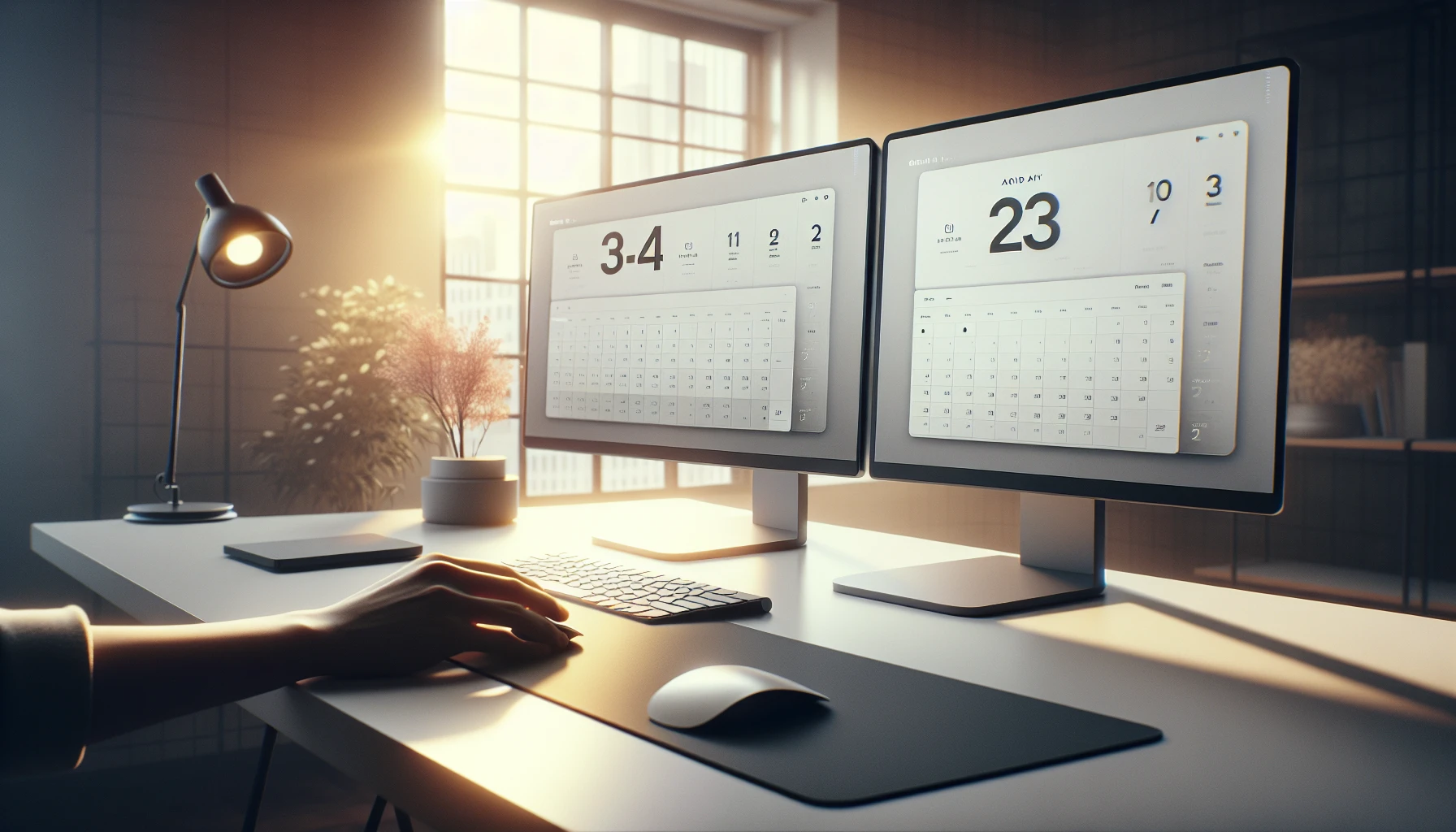· Ricardo Batista · 13 min read
Calendar Template Google Docs - How to plan your week
Set up Google Docs and Sheets calendars for monthly, weekly or yearly plans; live updates, shared links help keep track.

This guide will show you useful tips to set up a flexible calendar template using Google docs and sheets. It compares features with project management tools like ClickUp and Smartsheet, along with handy add-ons for slide creation such as SlidesAI. We break down simple steps to integrate shared calendars, and offer extra resources - all aimed at boosting everyday planning and productivity.
Key Takeaways
- Use Google Docs and Sheets templates to plan your week and month, making it easier to update your schedule on the fly
- Customize your calendar with simple changes like different colors and formats to suit your needs
- Leverage live updates and shared access so your team can keep up with what’s happening in real-time
- Our system automatically pings attendees who arrive late to meetings, showing real expertise in keeping everyone on track
- Integrate other tools like ClickUp and Smartsheet to expand functionality and streamline your planning process
Calendar Template Google Docs Basics
Google Docs offers a simple and flexible way to design and use calendar templates that fit everyday planning needs. Instead of spending time on elaborate designs, you can use basic tools to create calendars for monthly, weekly, or yearly use. For those who need to incorporate meeting reminders—like automatically pinging attendees who show up late—a well-made calendar template becomes even more valuable. The templates you design or choose can be integrated with other tools and platforms seamlessly.
When you begin, you should consider a few simple steps:
- Decide whether you want a monthly, weekly, or yearly layout
- Gather information on upcoming meetings and deadlines
- Identify which tools, like Google Sheets for dynamic data or Google Docs for static pages, suit your needs
This approach not only helps in planning your workweek but also provides a way to embed real-time scheduling updates and reminders. The overall strategy is to keep the process uncomplicated for a practical everyday workflow, almost as if you were setting up your college timetable.
Customizable Calendar Templates in Google Docs and Sheets
Google Docs and Google Sheets offer complementary ways to create customizable calendar templates. With Google Docs, you are free to format and design the template using tables and text boxes. In contrast, Google Sheets lets you add formulas and embed dynamic schedules that update automatically.
Using Google Docs for Calendar Templates
Google Docs is the ideal tool when you want to create a visually appealing calendar with text editing features, making it perfect for:
- Planning individual tasks and appointments
- Tracking meeting times and setting aside sections for reminders
- Sharing static versions of the template with colleagues
For instance, you can set up a table with columns for dates, time slot, meeting name, and notes. This format helps remind participants of important meeting details, and if needed, you could include callouts for late arrivals.
Leveraging Google Sheets for Dynamic Scheduling
If you need a calendar template that updates automatically, Google Sheets becomes the go-to choice. With its cell formula capabilities, you can:
- Automatically calculate dates for recurring meetings
- Integrate with APIs or other data sources for real-time scheduling updates
- Easily integrate sharing and collaborative features that suit remote teams
Since Google Sheets supports real-time editing, using it for your calendar template means you can have a shared calendar accessible by all team members, ensuring that everyone stays on the same page. Furthermore, if someone is running late, you can set up conditional formatting rules that highlight these changes and trigger a meeting reminder email or notification.
Step-by-Step Guide to Setting Up Calendar Templates
Creating a custom calendar template in Google Docs or Sheets is a straightforward process. Follow these basic steps to set up your template for both design flexibility and functional integration with meeting reminders.
Step 1: Choose Your Platform
- Decide on Docs for a more design-oriented calendar or Sheets for a dynamic, data-driven schedule.
- Open a new document in Google Docs or a new sheet in Google Sheets.
Step 2: Design the Layout
For Google Docs:
- Insert a table with a number of rows corresponding to weeks or days in a month (depending on your layout).
- Enter headers for date, day, time, meeting title, and notes.
- Customize the table design using simple formatting (bold for headers, shaded cells for weekends, etc.).
For Google Sheets:
- Create columns for each category such as Date, Time, Meeting, and Reminder.
- Use formulas to auto-fill dates and even apply conditional formatting that could highlight upcoming or missed meetings.
- Adjust the width and height of cells to mimic the feel of a calendar.
Step 3: Input Your Data
- Begin by manually entering the core details like meeting dates and times into your template.
- For recurring events, you can use the drag-and-fill function in Sheets or copy-paste rows in Docs.
- If you use Sheets, build formulas that can detect if a meeting starts late or if the system should trigger a reminder.
Step 4: Integrate Meeting Reminders
To automatically ping attendees who arrive late, you might need:
- An integration with another tool or script that sends alerts based on time thresholds.
- Use add-ons or third-party tools that work with your Google Docs or Sheets.
- For example, a script in Sheets could check the current time against the scheduled time and then use the data to send reminder emails or pop-up messages.
These steps are a nice starting point if you are entering a realm where every minute counts for team success. In this slightly disorganized digital age, getting these basics right can boost your everyday productivity .
Integrating Shared Calendars and Real-Time Scheduling Updates
Modern workplaces rely on shared calendars and real-time updates to keep team operations smooth. There are several methods to integrate these features into your calendar templates.
Using Google Calendar Integration
One straightforward method is linking your custom calendar to Google Calendar. While Google Calendar already comes with strong features for meeting notifications and reminders, a custom template in Docs or Sheets adds a layer of personalization:
- Import events from Google Calendar into Sheets using simple scripts
- Link back to your custom calendar so that every update is reflected in your meeting reminders system
- Use time-based trigger functions in Google Scripts to send meeting alerts or pings
Real-Time Scheduling with Google Sheets
If you use a Sheets-based calendar, take advantage of its real-time collaboration feature. This means:
- Anyone with access can update meeting details on the fly
- Late arrivals can trigger automatic updates that notify the team instantly
- The shared nature of the sheet means that if a meeting is rescheduled, all stakeholders see the change immediately
These techniques ensure that when meetings start late or when team members are running behind, an automated system triggers a reminder. For example, you might integrate a script that pings the attendees if they haven’t checked in 5 minutes past the scheduled start time. This method links into the concepts discussed in the Google Calendar Whatsapp Reminder.
Comparing Alternative Calendar Template Options
While Google Docs and Sheets are powerful and flexible, various platforms offer ready-made calendar templates that may meet more specialized needs. Evaluating these alternatives helps you choose the best tool for your specific circumstances.
ClickUp’s Ready-Made Calendar Templates
ClickUp is popular among project managers due to its ready-made templates and AI-powered features. Their templates often come with:
- Pre-built structures that fit different project needs
- Integrated task management, which includes meeting reminders and timely pings for late attendees
- A user-friendly interface that minimizes the setup time
Even though ClickUp’s options are attractive, you might prefer the freedom of customizing your own calendar in Google Docs or Sheets if you value simplicity and full control over the final look.
Advanced Project Management with Smartsheet
Smartsheet caters to those looking for advanced project management solutions. Its features include:
- Robust integration capabilities for enterprise needs
- Collaborative features that ensure all changes are visible in real-time
- Customizable templates that can be tailored to send automated meeting reminders when scheduling anomalies occur
While Smartsheet offers powerful functionalities, the cost and complexity might not be justified for smaller teams or individual use. For many, a Google Docs template remains the easiest option as it can be modified on the fly without investing in new software.
Utilizing Add-Ons and External Resources
Boosting the functionality of your calendar templates can easily be achieved by using additional resources and add-ons. These options expand what you can do with a simple document or spreadsheet.
SlidesAI for Google Slides Presentations
If you need to present your meeting schedules or calendar layouts, SlidesAI is a handy add-on for Google Slides. It allows you to create visually appealing presentations from your existing calendar data. With SlidesAI:
- Convert calendar information into slide format effortlessly
- Share schedules during remote meetings or team briefings
- Edit and update the slides on the fly as new data comes in
Free Alternatives and Add-Ons
There are several free alternatives that provide further enhancements for your workflow:
- Thegoodocs offers free templates and add-ons that boost productivity and streamline document creation.
- Docs Rocks is another resource that provides useful templates for Google Docs, perfect for beginners who need a simple yet effective layout.
- Supercharge Google Docs add-ons deliver extended functionalities such as automated formatting and integrated reminder systems.
These add-ons and external resources can be particularly useful if you want to incorporate meeting reminder functionalities directly into your calendar. Such tools help ensure that if attendees arrive late, your system can instantly send a ping or a reminder message. Using Meeting Reminder Template guidelines can help you set this up effectively.
Boosting Workflow with Meeting Reminders
One of the most valuable aspects of a well-designed calendar template is its ability to integrate meeting reminders. In busy environments, it is crucial to have a mechanism that notifies everyone when delays occur. Meeting reminders help in managing time better and ensuring accountability.
Setting Up Automated Meeting Reminders
Here are some simple steps to set up automated pings for late attendees:
- Determine the threshold for lateness (for instance, 5 minutes past the scheduled start time)
- Use conditional formulas in Google Sheets to compare the current time with the scheduled meeting time
- If a meeting is marked as delayed, trigger a pop-up notification or an email reminder
- Ensure that the script sends reminders to all participants, reinforcing accountability
These steps can be enhanced by using third-party integrations that connect with your calendar template. You might integrate a tool that automatically pings participants on a chat platform or via email as soon as the threshold is reached.
Practical Tips for Managing Late Arrivals
Managing meetings efficiently involves more than just scheduling. Consider these measures:
- Clearly state the start time and the buffer period in the calendar layout.
- Use visually distinct markers (like different cell colors in Sheets) to indicate upcoming or delayed meetings.
- Communicate the importance of punctuality in the template’s notes section.
- Encourage team members to set up personal reminders alongside the automated ones.
By implementing these strategies, your custom calendar template not only serves as a scheduling tool but also as a reliable system for sending meeting reminders, ensuring that everyone stays on track.
Leveraging Internal Resources
For further ideas on how to set up reminders, check out the detailed guide on Calendar Reminder. This guide explains how to integrate different systems to achieve smooth meeting flow and punctuality. Using similar strategies, you can enhance your calendar template to work effectively with your existing tools.
By mixing the design flexibility of Google Docs with the dynamic functions of Google Sheets, you create a powerful tool for daily planning. Integrating add-ons and external resources makes your calendar not just a document but a hub for scheduling, meeting reminders, and real-time updates. This approach suits anyone who values a bit of customization and automation—even if you’re a 20-year-old juggling study and part-time work.
Using these simple, actionable steps can significantly boost your workflow. Whether you prefer to tweak your calendar layout in Google Docs and then share it with others via Google Sheets, or if you lean towards ready-made options like those from ClickUp or Smartsheet, the important part is that you have access to a clear, functional tool. A well-set-up calendar template is a cornerstone of effective time management and brief, timely communications.
- Understand the basics and decide whether a static or dynamic layout best suits your needs.
- Follow a step-by-step process to build your template and integrate automated meeting reminders.
- Explore alternatives if you need more advanced project management features but keep in mind the simplicity and control Google Docs and Sheets offer.
- Utilize additional resources like SlidesAI for presentations and free add-ons from Thegoodocs, Docs Rocks, and others to further boost your productivity.
Ensuring every member is on time is crucial in any team setup, and having a calendar that pings those who are late guarantees that you always know where everyone stands. This kind of system, aligned with the strategies outlined in a Calendar Reminder resource, offers both simplicity and efficiency in managing daily meetings and long-term projects.
Conclusion
We’ve gone through the basics of using calendar templates in Google Docs and Sheets, and it is clear that even simple tools can make planning your week or month a lot easier. The central theme was about setting up live, shared calendars, whether for monthly or weekly plans, and how adding customizable templates simplifies the whole process. Two key things to take away are understanding how to set these up and the benefit of integrating real-time updates with your schedule. And then there’s the extra help from neat add-ons and comparing tools like ClickUp’s calendar templates which have cool AI features, making your planning session even more productive sometimes.
Our guide showed that with a bit of effort, you can turn basic Google Docs into a powerful planning space. It all adds up to better time management. Remember, if you need help making sure your meetings run smoothly, Meeting Reminders automatically pings attendees that arrive late to your meetings, keeping everyone on track. Take a moment to try out these steps and watch your scheduling skills improve.
Frequently Asked Questions (FAQs)
How do I set up a calendar template Google Docs for my project?
You can start by opening a new Google Doc and exploring the built-in template gallery. Pick a calendar template that fits your needs, whether it’s monthly or weekly. Customize it by adding your events and deadlines. It isn’t super complicated once you get the hang of it.
Can I edit a calendar template Google Docs to track my personal goals?
Yep, totally! You just need to tweak the design a bit—change the colors, add your tasks, and update the dates. It works well when you want a clear overview of your schedule for both work and personal goals. This flexibility is what makes using Google Docs so cool.
What makes a calendar template Google Docs better than using a physical planner?
Using Google Docs means your calendar is available anywhere, just with an internet connection. It lets you easily share it with friends, colleagues, or classmates and get real-time updates. It also makes it simple to make last-minute changes, unlike a physical planner that’s hard to update.
How do I share my calendar template Google Docs with my team?
Sharing is simple! You just click on the “Share” button in Google Docs, set the permissions (like edit, view, etc.), and then send the link to your team. This way, everyone stays in the loop and it ensures better collaboration on your projects.
How do you automatically ping the attendees that arrive late to your meetings using my calendar template Google Docs?
This might sound a bit advanced, but it’s actually pretty neat. Tools like Meeting Reminders can integrate with your Google Calendar and Docs setup to send an alert if someone shows up late. It automates the follow-up process so you don’t have to manually message each person. This integration shows our expertise in keeping meetings on track efficiently even if you’re juggling a hectic schedule.



